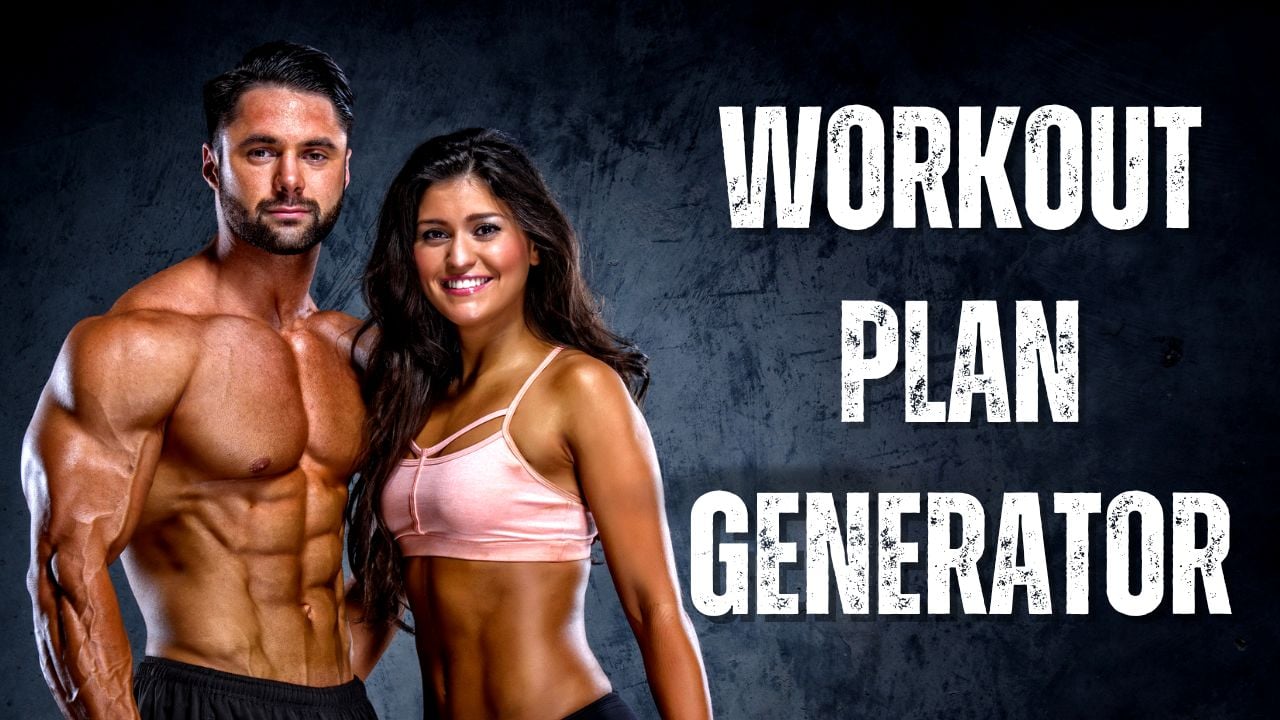💪 AI Workout Plan Generator

How the AI Workout Plan Generator Works 🤖
🤖 Intelligent Exercise Selection
Our AI-powered workout generator uses evidence-based exercise science to create personalized training programs. The system analyzes your goals, experience level, available equipment, and time constraints to select optimal exercises from a comprehensive database. Each exercise is chosen based on biomechanical efficiency, muscle activation patterns, and alignment with your specific training objectives. The generator incorporates progressive overload principles and periodization strategies validated by sports science research.
📊 Volume and Intensity Optimization
Training volume (sets × reps × weight) is the primary driver of muscle growth and strength gains. Our generator calculates optimal weekly training volume based on your experience level and recovery capacity:
Example: Intermediate lifter, Muscle Building goal
= 12 sets/muscle group × 1.3 (intermediate) × 1.2 (hypertrophy) = 18-20 sets per muscle per week
This approach follows the dose-response relationship research showing that training volume significantly impacts muscle hypertrophy. The generator also adjusts intensity (load) based on your goal: higher reps (8-12) for hypertrophy, moderate reps (4-6) for strength, and lower reps (12-15+) for endurance.
🎯 Goal-Specific Programming
Different training goals require distinct programming approaches:
- Muscle Building (Hypertrophy): Moderate loads (65-85% 1RM), 8-12 reps, 3-5 sets per exercise, 60-90 second rest periods
- Strength Gains: Heavy loads (80-95% 1RM), 1-6 reps, 3-6 sets per exercise, 3-5 minute rest periods
- Fat Loss: Circuit-style training, moderate loads, 10-15 reps, shorter rest (30-60 seconds), higher training frequency
- Athletic Performance: Power-focused exercises, explosive movements, plyometrics, sport-specific patterns
- General Fitness: Balanced approach combining strength, endurance, and functional movements
- Muscular Endurance: Light-moderate loads (40-60% 1RM), 15-20+ reps, minimal rest (30-45 seconds)
Best Workout Splits
💪 Full Body Training
Best For: Beginners, 2-3 day schedules, general fitness goals
Full body workouts train all major muscle groups in each session. This approach maximizes training frequency (hitting each muscle
2-3x per week) which is ideal for beginners and time-constrained individuals. Research shows
higher training frequency can enhance muscle protein synthesis and overall growth. Each session typically includes:
- 1-2 compound lower body exercises (squats, deadlifts)
- 2-3 upper body pushing movements (bench press, shoulder press)
- 2-3 upper body pulling movements (rows, pull-ups)
- 1-2 core exercises
Full body training also supports weight loss programs by maximizing calorie expenditure and maintaining muscle mass during fat loss phases.
🔄 Upper/Lower Split
Best For: Intermediate lifters, 4-day schedules, balanced development
The Upper/Lower split divides training into upper body days and lower body days, typically performed 4 days per week
(Upper/Lower/Rest/Upper/Lower). This allows higher volume per muscle group while maintaining adequate frequency.
Training each muscle group twice weekly provides optimal stimulus for both hypertrophy and strength development.
Upper Body Focus: Chest, back, shoulders, arms
Lower Body Focus: Quads, hamstrings, glutes, calves, core
This split is particularly effective for those following muscle building programs as it balances training volume with recovery. You can also integrate specialized training like leg exercises and chest workouts.
⚡ Push/Pull/Legs (PPL)
Best For: Intermediate-advanced lifters, 5-6 day schedules, high volume training
PPL divides training by movement patterns: pushing muscles (chest, shoulders, triceps), pulling muscles (back, biceps),
and legs. This split allows for high frequency and volume while grouping synergistic muscles together. The typical structure:
- Push Day: Chest exercises, shoulder movements, tricep work
- Pull Day: Back training, rear delts, bicep exercises
- Leg Day: Quad exercises, hamstring training, calf work
PPL can be run as a 3-day cycle (training each muscle group 2x per week when running 6 days) or as a single cycle per week. This split is popular among bodybuilders and advanced lifters seeking maximum muscle development.
🎯 Bro Split (Body Part Split)
Best For: Advanced lifters, 5-6 day schedules, targeting weak points
The classic bodybuilding split dedicating one day to each major muscle group. While lower frequency (each muscle trained 1x per week),
it allows extremely high volume per session and is effective for advanced lifters who need more recovery time. Typical structure:
- Monday: Chest Day
- Tuesday: Back Day
- Wednesday: Shoulder Day
- Thursday: Arms (Biceps/Triceps)
- Friday: Leg Day
- Saturday: Optional (abs, weak points)
While research suggests higher frequency may be superior for beginners, advanced lifters with significant training volume requirements may benefit from body part splits to manage fatigue and allow adequate recovery between sessions.
Training Volume Guidelines by Experience
| Experience Level | Weekly Sets/Muscle | Exercises/Muscle | Training Days | Session Duration |
|---|---|---|---|---|
| Beginner (0-1 year) | 10-12 sets | 2-3 exercises | 2-4 days/week | 30-45 minutes |
| Intermediate (1-3 years) | 15-20 sets | 3-5 exercises | 4-5 days/week | 45-75 minutes |
| Advanced (3+ years) | 20-25+ sets | 4-6 exercises | 5-6 days/week | 60-90 minutes |
Note: Volume recommendations based on systematic review research on dose-response relationships. Individual needs may vary based on genetics, recovery capacity, and training history. Track your progress with our workout volume calculator.
Rep Ranges for Different Goals
| Training Goal | Rep Range | Load (% 1RM) | Rest Period | Primary Adaptation |
|---|---|---|---|---|
| Maximum Strength | 1-5 reps | 85-100% | 3-5 minutes | Neural efficiency, motor unit recruitment |
| Strength-Hypertrophy | 6-8 reps | 75-85% | 2-3 minutes | Balanced strength and muscle growth |
| Hypertrophy (Muscle Growth) | 8-12 reps | 65-75% | 60-90 seconds | Muscle fiber damage, metabolic stress |
| Muscular Endurance | 15-20+ reps | 40-60% | 30-60 seconds | Oxidative capacity, fatigue resistance |
| Power Development | 1-5 reps | 50-70% | 3-5 minutes | Rate of force development, explosiveness |
Note: Rep ranges are guidelines, not rigid rules. Recent research shows muscle growth can occur across a wide range of rep schemes when sets are taken close to failure. Calculate your training loads with our 1RM calculator.
Progressive Overload Strategies
📈 What is Progressive Overload?
Progressive overload is the gradual increase of stress placed on the body during training. It’s the fundamental principle driving all fitness adaptations—whether building muscle, gaining strength, or improving endurance. Without progressive overload, your body has no reason to adapt and improve.
Where: Volume = Sets × Reps × Load
Intensity = Effort level (proximity to failure)
Frequency = Training sessions per week
Example Progression:
Week 1: 3 sets × 10 reps × 100 lbs = 3,000 lbs volume
Week 4: 4 sets × 10 reps × 110 lbs = 4,400 lbs volume
= 47% increase in training stimulus
To implement progressive overload effectively:
- Increase Weight: Add 2.5-5 lbs to upper body exercises, 5-10 lbs to lower body when you can complete all prescribed reps
- Add Reps: Perform more reps with the same weight (e.g., 3×8 → 3×10 → 3×12)
- Add Sets: Increase training volume by adding sets (e.g., 3×10 → 4×10)
- Improve Form: Execute exercises with better technique and control
- Reduce Rest: Decrease rest periods while maintaining performance
- Increase Frequency: Train muscle groups more often per week
Track your workouts systematically using a training log or app. Without tracking, progressive overload becomes guesswork. Monitor your weekly training volume and ensure you’re consistently progressing over time.
🔄 Periodization and Training Cycles
Periodization is the systematic planning of training to optimize performance and prevent plateaus. Rather than training at maximum intensity year-round, periodization involves planned variations in training variables across different time periods.
Linear Periodization: Gradually increase intensity while decreasing volume over several weeks or months. For example: 4 weeks @ 3×12 (hypertrophy) → 4 weeks @ 4×8 (strength) → 4 weeks @ 5×5 (max strength)
Undulating Periodization: Vary intensity and volume more frequently (daily or weekly). Monday: 4×8 @ 75%, Wednesday: 3×12 @ 65%, Friday: 5×5 @ 85%. Research suggests undulating periodization may be superior for long-term strength gains.
Block Periodization: Focus on specific training qualities in 2-4 week blocks (accumulation → intensification → realization). Popular among advanced athletes and powerlifters.
Exercise Selection by Equipment
🏋️ Full Gym Equipment
Access to a fully-equipped gym provides the most exercise variety and progressive overload options. Key equipment includes:
- Barbell & Plates: Foundation for compound movements (barbell exercises)
- Dumbbells: Unilateral training and stabilization (dumbbell exercise library)
- Cable Machines: Constant tension and variable angles (cable exercises)
- Machines: Isolated movements and safety (gym machines guide)
- Squat/Power Rack: Safe heavy compound lifting
Full gym access allows optimal implementation of progressive overload through precise weight increments and exercise variety. You can target muscles from multiple angles using different equipment modalities for comprehensive development.
🏠 Home Gym (Basic Equipment)
Effective training is possible with minimal equipment. A basic home setup includes:
- Adjustable Dumbbells: Core of home training, versatile for all muscle groups (dumbbell programs)
- Resistance Bands: Variable resistance, joint-friendly, portable (band exercises)
- Pull-Up Bar: Essential for back development and upper body pulling (pull-up variations)
- Adjustable Bench: Enables pressing angles and support for various exercises
Home training requires creativity but can deliver excellent results. Focus on progressive overload through increased reps, slower tempos, pauses, and eventually adding weight. Many home workout plans achieve comparable results to gym-based training.
💪 Bodyweight Only
Bodyweight training requires zero equipment and can build significant strength and muscle. Key progressions include:
- Push-Up Progressions: Wall push-ups → knee push-ups → standard → decline → diamond push-ups → one-arm progressions
- Pull-Up Progressions: Negatives → assisted → full pull-ups → weighted → one-arm progressions
- Squat Progressions: Bodyweight squats → pistol squats → shrimp squats
- Core Work: Plank variations, hollow holds, L-sits
Progressive overload with bodyweight training comes from leverage disadvantages, tempo manipulation, and skill progressions. Follow structured calisthenics programs and bodyweight routines for systematic progression.
Workout Plan Generator FAQs
❓ How does the AI Workout Plan Generator work?
Our AI generator uses a sophisticated algorithm that analyzes your inputs (goal, experience, frequency, equipment, duration) and creates a personalized workout plan based on exercise science principles. The system draws from a comprehensive exercise database and applies progressive overload strategies, optimal rep ranges for your goals, and appropriate training volumes based on your experience level. Each plan is unique and tailored to your specific circumstances.
💪 How often should I change my workout plan?
Generally, stick with a program for 4-8 weeks before changing. Frequent changes prevent you from tracking progress and applying progressive overload effectively. However, consider changing if: you’ve stopped progressing for 2-3 weeks despite proper execution, you’ve become bored and motivation is suffering, or you’ve achieved your current goal and want to focus on a different one. Our generator allows you to create new plans as your needs evolve.
🎯 Can I build muscle with home equipment only?
Absolutely! While a fully-equipped gym provides more options, significant muscle growth is achievable with basic home equipment (dumbbells, resistance bands, pull-up bar). The key is progressive overload—consistently increasing the challenge to your muscles. Home training may require more creativity (tempo variations, pause reps, increased volume) but can deliver excellent results. Many people have built impressive physiques training at home, especially when following structured home workout programs.
⏰ What if I can only train 2-3 days per week?
You can still make excellent progress with 2-3 training days. Full body workouts are most effective for this frequency, allowing you to hit each muscle group multiple times per week. Focus on compound exercises (squats, deadlifts, presses, rows) that train multiple muscles simultaneously. Maximize each session by using appropriate intensity and volume. Research shows that 2-3 weekly sessions can produce significant strength and hypertrophy gains when programmed properly.
📈 How do I track my progress?
Track your workouts systematically by recording: exercises performed, sets, reps, and weight used for each session. Use a training log, spreadsheet, or fitness app. Progress indicators include: increased weight for the same reps, more reps with the same weight, improved form and control, faster recovery between sets, and body composition changes (photos, measurements, weight). Take progress photos monthly and track body measurements bi-weekly. Use our body fat calculator and FFMI calculator to monitor body composition changes.
⚕️ Medical & Training Disclaimer
This AI Workout Plan Generator provides general fitness guidance based on exercise science principles and should not replace professional coaching or medical advice. Before beginning any new exercise program, consult with a qualified healthcare professional, especially if you have pre-existing health conditions, injuries, or are new to exercise. The generated workout plans are educational tools and may need modification based on individual factors including injury history, biomechanics, recovery capacity, and personal preferences. Listen to your body, use proper form, and progress gradually. If you experience pain (beyond normal muscle fatigue), dizziness, or any concerning symptoms, stop exercising immediately and seek professional guidance. Consider working with a certified personal trainer or strength coach for personalized instruction and form corrections. This tool is for informational and educational purposes only.

Manish is a NASM-certified fitness and nutrition coach with over 10 years of experience in weight lifting and fat loss fitness coaching. He specializes in gym-based training and has a lot of knowledge about exercise, lifting technique, biomechanics, and more.
Through “Fit Life Regime,” he generously shares the insights he’s gained over a decade in the field. His goal is to equip others with the knowledge to start their own fitness journey.
